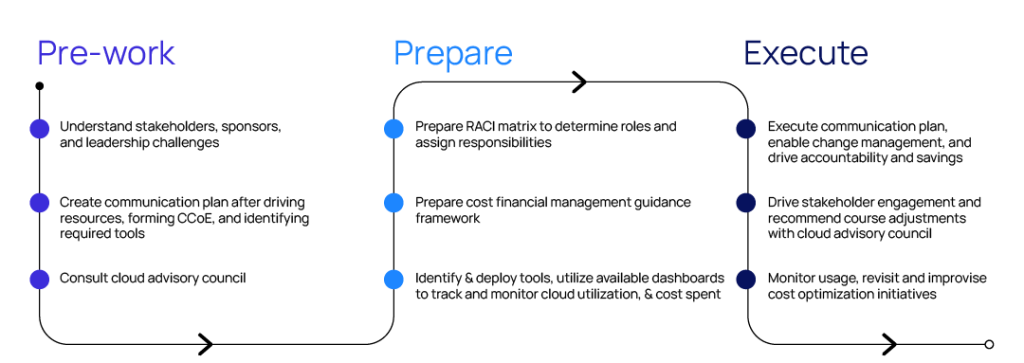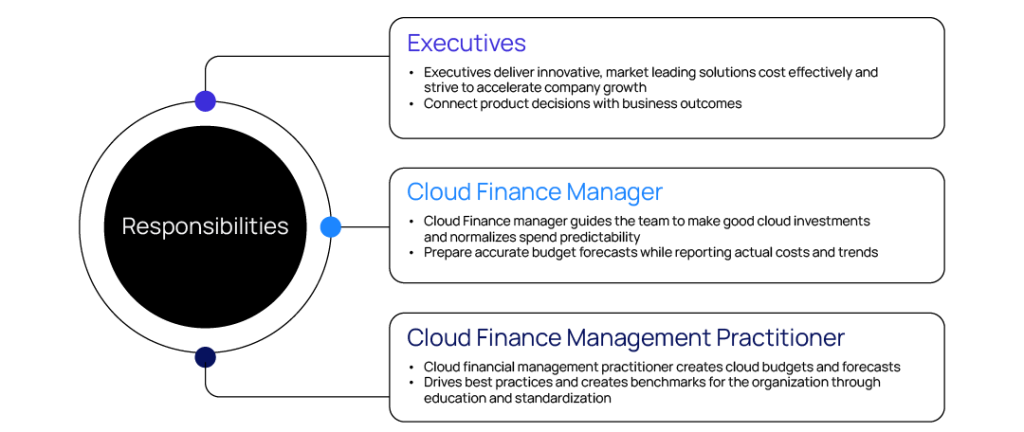This website uses cookies. By continuing to browse the site, you are agreeing to our use of cookies
Streamline Your Cloud Finances with Hexaware’s Cloud Financial Management Solutions
Cloud
April 24, 2023
Cloud adoption has become an integral component of modern business, offering exceptional flexibility and scalability to enterprises of all sizes. However, cost optimization has become a top priority for C-level executives as more workloads migrate to the cloud. According to the Flexera 2023 State of the Cloud Report, 62% of the organizations stated that one of their top cloud initiatives for 2023 is optimizing the existing use of the cloud (cost savings), while 44% have indicated that they plan to migrate more workloads to the cloud. Despite investing countless hours and intense efforts, a substantial amount of cloud spending is wasted. This results in the accumulation of technical and financial debt and impacts enterprise performance and the ability to grow in this volatile environment.
Organizations estimate that up to 28% of their cloud spending is wasted

Fig 1: Estimated wasted cloud spend

Fig 2: Top IT initiatives for 2023
The easiest yet effective solution to break free from this deadlock is to abandon the short-term financial fix and focus on a long-term solution with cloud financial management. This can help organizations better understand the costs and usage of cloud services, regardless of whether they have already adopted cloud services or are planning to do so.
Understanding Cloud Financial Management
Cloud financial management is an evolving discipline and cultural practice enabling organizations to maximize business value by collaborating with engineering, finance, and business teams on data-driven spending decisions. It consists of principles, phases, personas, and tools, enabling organizations to manage their cloud spend to maximize their investment. Cloud financial management is essential because it can help:
- Improve IT efficiency
Managing cloud costs efficiently helps IT pros focus on core duties, ensuring workloads run smoothly on the cloud. - Make logical financial decisions
Cloud cost management shows the Cost to Value based on cloud usage and pricing. It helps in making the right calls on future cloud utilization best practices. - Remove inefficient features
Cloud optimization identifies the essential minimum cloud services required to get things done affordably, quickly, and without too much fuss. - Avoid unforeseen cloud billing surge
Cloud cost management boosts visibility into the usage of cloud services, ensuring organizations are a step ahead of any unnecessary charges that could creep into future bills.
The Challenges Associated with Managing Cloud Finances
Some of the significant cloud cost management challenges are as follows:
- Establishing adequate cost controls: In large enterprises focusing on business, IT is generally overlooked, primarily when the cost is borne by the vertical rather than the application teams. There is a dire need to establish the right controls on the cloud to monitor the expenditure and ensure that the right services are used judicially and efficiently.
- Lack of cost visibility: Organizations maintain their assets and track resources through CMDB (Configuration Management Database). Resources created on the cloud do not provide similar-level insights unless access is provided explicitly to the cloud subscriptions. Defining and integrating the cloud resource lifecycle with enterprise CMDB can help understand and track cloud usage, providing opportunities to optimize it simultaneously.
- Dynamic usage patterns: The dynamic nature of cloud usage means that costs can quickly spiral out of control if not closely monitored. The ability to easily scale cloud resources up or down in response to changing demands can lead to unexpected costs.
- Multiple cloud providers: Many organizations use multiple cloud providers, making it challenging to manage costs across different platforms. Each provider has its own pricing model and tools, which makes it challenging to compare costs and optimize cloud spending.
- Optimizing resource utilization: Optimizing cloud costs is challenging due to a lack of experience, strategies, and effective planning. Besides, deciding what to do, how to do it, and how to take advantage of cost-saving opportunities can be very expensive for businesses.
- Too many shared resources: Managing shared resources is difficult in a complex and distributed environment. The lack of strategies and methodology in shredding the cost ownership ultimately results in no ownership and might lead to expenditure overrun.
- Unclear billing practices: Cloud billing practices are often unclear and difficult to understand. This can make it challenging to plan effectively and forecast costs.
Hexaware’s Approach to Cloud Financial Management
Cloud financial management can be daunting for many business owners and managers. However, Hexaware can assist enterprises in setting up proper guardrails and creating a tailored financial management program based on industry-leading technology and strong domain expertise. Along with providing cloud consulting and advisory services, Hexaware uncovers hidden costs, identifies opportunities for optimizing on the cloud, extends a comprehensive cloud governance framework, and streamlines your cloud transformation journey. We have a well-defined roadmap that helps customers easily optimize their cloud costs.

Fig 3: Hexaware’s cloud financial management roadmap
Hexaware comprehends business challenges, gathers resource knowledge, and develops a communication strategy. After understanding the client environment and expectations, we create a financial management guidelines framework and assist them in preparing RACI Matrix to define the team’s rules and responsibilities. For a smooth cloud financial management process, we recommend forming a team of at least three members as envisioned below:

Fig 4: Hexaware-recommended personas and responsibilities
With careful planning and a deep understanding of the technology and services, Hexaware’s cloud financial management framework provides a strategic solution involving a variety of areas:
- Providing realistic budgeting with provision for additional services.
- Analyzing the current usage trends and forecasting future demand.
- Ensuring security and compliance with organizational standards and regularly monitoring for updates or changes.
Hexaware develops a tailored framework that meets the customer’s current and future business requirements by analyzing their current cloud environment, strategy, and governance maturity. We then recommend best practices around cloud governance, technology, financial management, roles & responsibilities, and operational guidelines.
Check out our cloud capabilities at https://hexaware.com/services/cloud-transformation/ to learn how we can help you optimize your cloud cost.
Reference
- Flexera 2023 State of the Cloud Report- https://www.flexera.com/blog/cloud/cloud-computing-trends-flexera-2023-state-of-the-cloud-report/
About the Author

Pawan Modi
Read more
Related Blogs

Ready to Pursue Opportunity?
Every outcome starts with a conversation
















